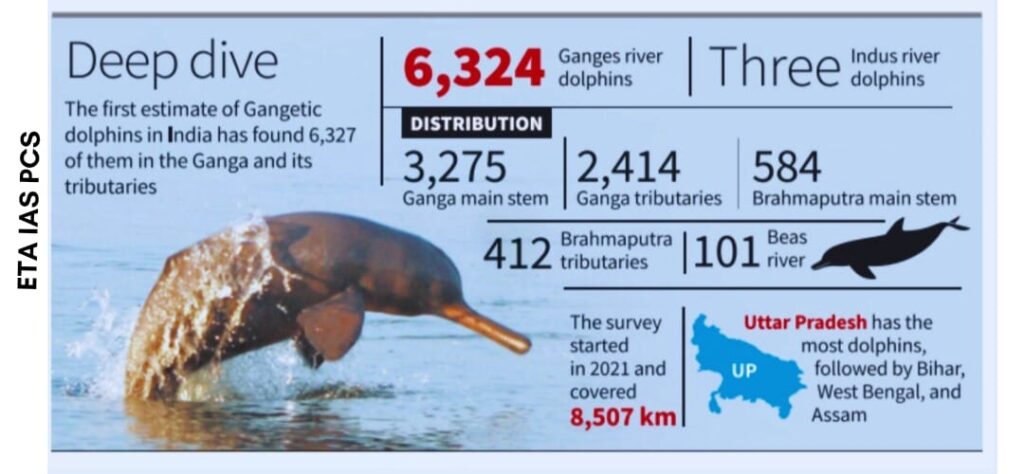CONTEXT: A groundbreaking survey focused on river dolphins has provided a population estimate of 6,327 individuals, predominantly located in the Ganga, Brahmaputra, and Indus river basins spanning eight states in India.
Key Findings of the Report
Population Data:
- The Ganges river dolphin population was recorded at 6,324 individuals.
- Additionally, three Indus river dolphins, a closely related species, were also recorded.
Geographical Distribution:
- The Gangetic dolphins were found in various locations, including:
- The Ganga River and its tributaries
- The Brahmaputra River and its tributaries
- The Beas River.
- The Gangetic dolphins were found in various locations, including:
Survey Details:
- This was the inaugural survey conducted by the Wildlife Institute of India in collaboration with the forest departments of multiple states.
- The survey was part of Project Dolphin, which was initiated in 2020.
- A subsequent survey is expected to take place in four years.
Dolphin Concentration:
- The highest concentration of dolphins was found in Uttar Pradesh, particularly in the Chambal River.
- Other notable concentrations were found in Bihar, West Bengal, and Assam.
Acoustic Survey Method:
- Researchers used boats traveling at a steady speed and employed acoustic hydrophones (underwater microphones) to capture the sounds produced by the dolphins during the survey.

India’s River Dolphins:
- Species Overview:
- India is home to two of the five known species of river dolphins globally: the Gangetic Dolphin and the Indus River Dolphin.
- These species predominantly inhabit the Indian subcontinent, particularly within the Ganga-Brahmaputra-Meghna and Karnaphuli-Sangu river systems.
Key Characteristics of the Gangetic Dolphin:
Size and Weight:
- Adult Gangetic Dolphins weigh between 70 kg and 90 kg.
- Males measure around 2 to 2.2 meters in length, while females are slightly larger, ranging from 2.4 to 2.6 meters.
Breeding Season:
- The breeding season for this species occurs from January to June.
Behavior and Feeding:
- Gangetic Dolphins are known for their shyness, often avoiding human interaction.
- Their diet primarily consists of various fish species and invertebrates.
- Dolphins tend to remain submerged in water, surfacing only occasionally to breathe.
Significance of River Dolphins:
- Umbrella Species: Dolphins serve as umbrella species, meaning their conservation efforts benefit their habitat and enhance overall biodiversity.
- Bio-indicators: Dolphins are recognized as bio-indicators, reflecting the health of river ecosystems and providing insights into environmental conditions.
Conservation Status (Both Species):
- IUCN Status: Endangered
- CITES: Appendix I
- Wildlife Protection Act, 1972: Schedule I
Threats to River Dolphins:
- The primary threats to these dolphins include:
- Entanglement in fishing nets
- River pollution
- Habitat loss due to the construction of dams and barrages
- Poaching
Dolphin Conservation Initiatives:
Conservation Action Plan (2010-2020):
- The Conservation Action Plan for the Ganges River Dolphin (2010-2020) was designed to protect this species and its habitats.
Project Dolphin (2020):
- Project Dolphin was launched in 2020 with the aim to raise awareness and involve local communities in conservation activities.
Comprehensive Action Plan (2022-2047):
- A Comprehensive Action Plan (2022-2047) has been put in place to ensure the safeguarding of the river dolphin and its aquatic environments.
National Recognition:
- The Ganges river dolphin has been officially declared the National Aquatic Animal of India.
Support under Centrally Sponsored Scheme:
- The Ministry of Environment, Forest and Climate Change (MoEFCC) has classified the Ganges river dolphin as one of 22 critically endangered species eligible for financial support under the Centrally Sponsored Scheme for the Development of Wildlife Habitats.
Protected Areas for Habitat Conservation:
- Key habitats for the Gangetic river dolphin, such as the Vikramshila Dolphin Sanctuary in Bihar, have been designated as Protected Areas.
Echolocation:
Definition and Function:
- Echolocation is the biological process where animals use sound for navigation.
- This system, also known as bio sonar, involves producing calls and interpreting the returning echoes from nearby objects.
Functions of Echolocation:
- Echolocation helps in:
- Navigation
- Foraging
- Hunting prey
- Echolocation helps in:
Echolocation serves as a crucial tool for various animals in both aerial and aquatic environments, aiding in survival and environmental interaction.
Ganges Dolphin and Echolocation:
- Ganges river dolphin most typically makes echolocation sounds such as clicks, bursts, and twitters.
- As the dolphin is blind, it produces an ultrasonic sound that is echoed off other fish and water species which allows it to identify prey.
- Echolocation is used for population counts by using acoustic surveying.
